Alison Lyke's Blog, page 4
June 19, 2020
Writing Alignment: Chaotic Evil
I adapted this blog series from a section of an online workshop I conducted for Writers & Books in March 2020.  The Situation Deciding a character’s alignment helps determine how they act during their adventures. I find it helpful to think about how each alignment would behave in the same circumstances because it highlights the differences between each alignment.
The Situation Deciding a character’s alignment helps determine how they act during their adventures. I find it helpful to think about how each alignment would behave in the same circumstances because it highlights the differences between each alignment.
Here’s the scene:
A character is in a market and encounters a thief who has stolen from them in a previous incident. The thief doesn’t see the character yet, so they have time to react. How will they act?
 A chaotic evil character will viciously pursue the thief with little regard for the safety of the rest of the public in the market–like throwing a grenade at your garden to uproot a weed. There’s also a chance she will ignore the thief, her reaction will depend on how badly she wants the stolen item back and her feelings toward the thief. If she sees the thief as a kindred spirit, she may invite him to join in on her anarchy. Defining Chaotic Evil Characters
A chaotic evil character will viciously pursue the thief with little regard for the safety of the rest of the public in the market–like throwing a grenade at your garden to uproot a weed. There’s also a chance she will ignore the thief, her reaction will depend on how badly she wants the stolen item back and her feelings toward the thief. If she sees the thief as a kindred spirit, she may invite him to join in on her anarchy. Defining Chaotic Evil Characters
Loss of life and destruction of property mean nothing to the chaotic evil character. This disregard for any form of social contract usually springs from one of two poisoned wells: vendetta or insanity. Often time, the chaotic evil character is both–a psychotic bent on vengeance.
 Sometimes, a chaotic evil character has an obsession, and their actions all serve to further their infatuation. Having an obsession is not enough though to make her chaotic evil, though; there’s always an element of derangement in these characters. Chaotic evil characters are rarely antagonists unless the story is a character study, and they are never heroes. Chaotic evil character types include terrorists, mad scientists, psychos, and sociopaths.
Sometimes, a chaotic evil character has an obsession, and their actions all serve to further their infatuation. Having an obsession is not enough though to make her chaotic evil, though; there’s always an element of derangement in these characters. Chaotic evil characters are rarely antagonists unless the story is a character study, and they are never heroes. Chaotic evil character types include terrorists, mad scientists, psychos, and sociopaths.
Chaotic Evil Character Development
A chaotic evil character will get more evil or more chaotic. If she tends toward chaos, her behavior will get increasingly erratic as she descends into homicidal mania. While these characters can do an impressive amount of damage in a short amount of time, they either burn out or are apprehended because of their sloppy methods and lack of planning.
On the other hand, the character might become more evil. Instead of merely being chaotic, she could learn to sew the seeds of mass chaos through scheming and underhanded dealings. While her personality will still be unstable, she’ll be able to see her nefarious plots through to the end.
Chaotic Evil Character Examples
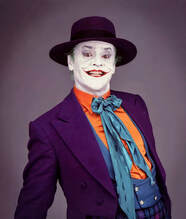 Iago from Shakespeare’s Othello is the “sewing the seeds of chaos” character type. He’s a master manipulator who harnesses the power of chaos to reach his goal. Iago doesn’t have the instability often seen with chaotic evil characters, aside from when he alters his personality to suit his needs.
Iago from Shakespeare’s Othello is the “sewing the seeds of chaos” character type. He’s a master manipulator who harnesses the power of chaos to reach his goal. Iago doesn’t have the instability often seen with chaotic evil characters, aside from when he alters his personality to suit his needs.
The Joker from the Batman franchise is the standard chaotic evil character who is wildly insane and bent on revenge. In many of his stories, the Joker becomes more villainous, starting out as petty and then moving on to enact more complex crimes.
Sweeney Todd, the Demon Barber of Fleet Street, is one of those rare chaotic evil characters who you might feel some sympathy for. Judge Turpin drove him to madness, and his reason for seeking vengeance is understandable. But, he kills people and eats them, so our understanding can only go so far. Next week I’m discussing neutral good characters!
Other Blogs in This Series:Intro to AlignmentLawful GoodChaotic GoodChaotic Neutral
 The Situation Deciding a character’s alignment helps determine how they act during their adventures. I find it helpful to think about how each alignment would behave in the same circumstances because it highlights the differences between each alignment.
The Situation Deciding a character’s alignment helps determine how they act during their adventures. I find it helpful to think about how each alignment would behave in the same circumstances because it highlights the differences between each alignment.
Here’s the scene:
A character is in a market and encounters a thief who has stolen from them in a previous incident. The thief doesn’t see the character yet, so they have time to react. How will they act?
 A chaotic evil character will viciously pursue the thief with little regard for the safety of the rest of the public in the market–like throwing a grenade at your garden to uproot a weed. There’s also a chance she will ignore the thief, her reaction will depend on how badly she wants the stolen item back and her feelings toward the thief. If she sees the thief as a kindred spirit, she may invite him to join in on her anarchy. Defining Chaotic Evil Characters
A chaotic evil character will viciously pursue the thief with little regard for the safety of the rest of the public in the market–like throwing a grenade at your garden to uproot a weed. There’s also a chance she will ignore the thief, her reaction will depend on how badly she wants the stolen item back and her feelings toward the thief. If she sees the thief as a kindred spirit, she may invite him to join in on her anarchy. Defining Chaotic Evil CharactersLoss of life and destruction of property mean nothing to the chaotic evil character. This disregard for any form of social contract usually springs from one of two poisoned wells: vendetta or insanity. Often time, the chaotic evil character is both–a psychotic bent on vengeance.
 Sometimes, a chaotic evil character has an obsession, and their actions all serve to further their infatuation. Having an obsession is not enough though to make her chaotic evil, though; there’s always an element of derangement in these characters. Chaotic evil characters are rarely antagonists unless the story is a character study, and they are never heroes. Chaotic evil character types include terrorists, mad scientists, psychos, and sociopaths.
Sometimes, a chaotic evil character has an obsession, and their actions all serve to further their infatuation. Having an obsession is not enough though to make her chaotic evil, though; there’s always an element of derangement in these characters. Chaotic evil characters are rarely antagonists unless the story is a character study, and they are never heroes. Chaotic evil character types include terrorists, mad scientists, psychos, and sociopaths.Chaotic Evil Character Development
A chaotic evil character will get more evil or more chaotic. If she tends toward chaos, her behavior will get increasingly erratic as she descends into homicidal mania. While these characters can do an impressive amount of damage in a short amount of time, they either burn out or are apprehended because of their sloppy methods and lack of planning.
On the other hand, the character might become more evil. Instead of merely being chaotic, she could learn to sew the seeds of mass chaos through scheming and underhanded dealings. While her personality will still be unstable, she’ll be able to see her nefarious plots through to the end.
Chaotic Evil Character Examples
 Iago from Shakespeare’s Othello is the “sewing the seeds of chaos” character type. He’s a master manipulator who harnesses the power of chaos to reach his goal. Iago doesn’t have the instability often seen with chaotic evil characters, aside from when he alters his personality to suit his needs.
Iago from Shakespeare’s Othello is the “sewing the seeds of chaos” character type. He’s a master manipulator who harnesses the power of chaos to reach his goal. Iago doesn’t have the instability often seen with chaotic evil characters, aside from when he alters his personality to suit his needs.The Joker from the Batman franchise is the standard chaotic evil character who is wildly insane and bent on revenge. In many of his stories, the Joker becomes more villainous, starting out as petty and then moving on to enact more complex crimes.
Sweeney Todd, the Demon Barber of Fleet Street, is one of those rare chaotic evil characters who you might feel some sympathy for. Judge Turpin drove him to madness, and his reason for seeking vengeance is understandable. But, he kills people and eats them, so our understanding can only go so far. Next week I’m discussing neutral good characters!
Other Blogs in This Series:Intro to AlignmentLawful GoodChaotic GoodChaotic Neutral
Published on June 19, 2020 12:59
June 12, 2020
Writing Alignment: Chaotic Neutral
This blog series is adapted from a section of an online workshop I conducted for Writers & Books in March 2020.
 The Situation Deciding a character’s alignment helps determine how they act during their adventures. I find it helpful to think about how each alignment would behave in the same circumstances because it highlights the differences between each alignment.
The Situation Deciding a character’s alignment helps determine how they act during their adventures. I find it helpful to think about how each alignment would behave in the same circumstances because it highlights the differences between each alignment.
Here’s the scene:
A character is in a market and encounters a thief who has stolen from them in a previous incident. The thief doesn’t see the character yet, so they have time to react. How will they act?
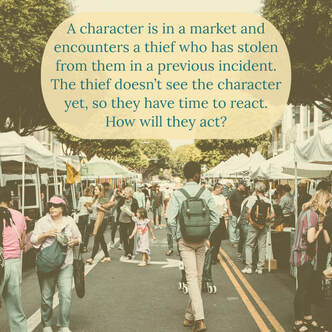 A chaotic neutral character is likely to ignore the thief altogether in favor of his own mad schemes. The fact that the thief stole something from him is low on his list of concerns unless the thief stole something precious to him or someone he loves. Then, he’ll pursue the thief in any number of erratic ways. He might chase him, attack him, throw something at him, or even silently stalk the thief home to ambush them. Or, maybe he’ll befriend the thief. It’s all on the table.
A chaotic neutral character is likely to ignore the thief altogether in favor of his own mad schemes. The fact that the thief stole something from him is low on his list of concerns unless the thief stole something precious to him or someone he loves. Then, he’ll pursue the thief in any number of erratic ways. He might chase him, attack him, throw something at him, or even silently stalk the thief home to ambush them. Or, maybe he’ll befriend the thief. It’s all on the table.
Defining Chaotic Neutral Characters
Chaotic neutral characters are the most unpredictable of all the alignments, and they are singular in their ability to cause mayhem. They are, however, not emotionless slaves to chaos. On the contrary, chaotic neutral characters are driven by strong emotions and the need to act on those feelings When a chaotic neutral character feels a sudden burst of joy, he acts on it. Maybe he expresses his joy by giving out flowers to passersby or by baking a copious amount of bread. When a chaotic neutral character feels jealousy, he acts on it as well. However, he’s just as likely to harm the subject of his envy as he is to befriend her. He may even ignore her in favor of improving himself until he’s no longer jealous. At times, he may cycle through emotions, and related actions, quickly, handing out flowers one moment and kicking a lady he’s jealous of the next.
When a chaotic neutral character feels a sudden burst of joy, he acts on it. Maybe he expresses his joy by giving out flowers to passersby or by baking a copious amount of bread. When a chaotic neutral character feels jealousy, he acts on it as well. However, he’s just as likely to harm the subject of his envy as he is to befriend her. He may even ignore her in favor of improving himself until he’s no longer jealous. At times, he may cycle through emotions, and related actions, quickly, handing out flowers one moment and kicking a lady he’s jealous of the next.
Chaotic neutral characters tend to be pirates, pranksters, and vigilantes. They are often exiled to the fringes of society due to their lack of desire, or ability, to control their emotions and actions, unless they live in a lawless or chaotic civilization.
Chaotic Neutral Character Development
A chaotic neutral character’s actions are not necessarily neutral, but his good actions and his evil actions cancel each other out, resulting in a net neutral. He’ll steal from the homeless encampment today and feed the homeless encampment tomorrow.
Extending the length of his moods is one way to develop a chaotic neutral character. He can move from being able to focus on a task for only a few minutes to staying on track for hours, then days. His actions will still be erratic, and he may be prone to outburst, but he’ll be able to set a goal and reach it, even if his goal only makes sense to himself.
Chaotic neutral characters may be devoted to someone or something. Though the character’s devotion rarely extends to a structured organization, he may have a love interest, or be dedicated to a loose ideology, such as hedonism or anarchy. His life journey may revolve around winning his love or becoming a master anarchist. In the end, however, the sum of his life will be almost as if he never existed, because a chaotic neutral character habitually nullifies any of his own achievements.
Chaotic Neutral Character Examples
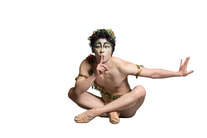 Dr. Frank N. Furter from The Rocky Horror Picture Show is an example of a chaotic neutral character devoted to hedonism. He has massive mood swings. He’s kind, manipulative, and selfish, almost simultaneously. He does, however, stay focused on a task and achieve a goal, a skill lacking on many chaotic neutral characters when they begin their adventures.
Dr. Frank N. Furter from The Rocky Horror Picture Show is an example of a chaotic neutral character devoted to hedonism. He has massive mood swings. He’s kind, manipulative, and selfish, almost simultaneously. He does, however, stay focused on a task and achieve a goal, a skill lacking on many chaotic neutral characters when they begin their adventures.
Gollum from Lord of the Rings has no idea what he’s doing. He has no plan and no goal outside of staying close to the ring until he’s able to get it back. Any good he does is quickly undone by his own evil actions.
Puck from A Midsummer’s Night Dream is the agent of chaos type of chaotic neutral character. He acts randomly and watches the results of his action as entertainment. He doesn’t mean harm, nor does he mean good. He just asks on his whims whenever they occur to him. “If we shadows have offended,
Think but this, and all is mended,
That you have but slumber’d here
While these visions did appear.
And this weak and idle theme,
No more yielding but a dream.” – Puck Next week I’ll be discussing Chaotic Evil Characters (shudder)!
See you then! Other Blogs in This Series:Intro to AlignmentLawful GoodChaotic Good
 The Situation Deciding a character’s alignment helps determine how they act during their adventures. I find it helpful to think about how each alignment would behave in the same circumstances because it highlights the differences between each alignment.
The Situation Deciding a character’s alignment helps determine how they act during their adventures. I find it helpful to think about how each alignment would behave in the same circumstances because it highlights the differences between each alignment.
Here’s the scene:
A character is in a market and encounters a thief who has stolen from them in a previous incident. The thief doesn’t see the character yet, so they have time to react. How will they act?
 A chaotic neutral character is likely to ignore the thief altogether in favor of his own mad schemes. The fact that the thief stole something from him is low on his list of concerns unless the thief stole something precious to him or someone he loves. Then, he’ll pursue the thief in any number of erratic ways. He might chase him, attack him, throw something at him, or even silently stalk the thief home to ambush them. Or, maybe he’ll befriend the thief. It’s all on the table.
A chaotic neutral character is likely to ignore the thief altogether in favor of his own mad schemes. The fact that the thief stole something from him is low on his list of concerns unless the thief stole something precious to him or someone he loves. Then, he’ll pursue the thief in any number of erratic ways. He might chase him, attack him, throw something at him, or even silently stalk the thief home to ambush them. Or, maybe he’ll befriend the thief. It’s all on the table. Defining Chaotic Neutral Characters
Chaotic neutral characters are the most unpredictable of all the alignments, and they are singular in their ability to cause mayhem. They are, however, not emotionless slaves to chaos. On the contrary, chaotic neutral characters are driven by strong emotions and the need to act on those feelings
 When a chaotic neutral character feels a sudden burst of joy, he acts on it. Maybe he expresses his joy by giving out flowers to passersby or by baking a copious amount of bread. When a chaotic neutral character feels jealousy, he acts on it as well. However, he’s just as likely to harm the subject of his envy as he is to befriend her. He may even ignore her in favor of improving himself until he’s no longer jealous. At times, he may cycle through emotions, and related actions, quickly, handing out flowers one moment and kicking a lady he’s jealous of the next.
When a chaotic neutral character feels a sudden burst of joy, he acts on it. Maybe he expresses his joy by giving out flowers to passersby or by baking a copious amount of bread. When a chaotic neutral character feels jealousy, he acts on it as well. However, he’s just as likely to harm the subject of his envy as he is to befriend her. He may even ignore her in favor of improving himself until he’s no longer jealous. At times, he may cycle through emotions, and related actions, quickly, handing out flowers one moment and kicking a lady he’s jealous of the next.
Chaotic neutral characters tend to be pirates, pranksters, and vigilantes. They are often exiled to the fringes of society due to their lack of desire, or ability, to control their emotions and actions, unless they live in a lawless or chaotic civilization.
Chaotic Neutral Character Development
A chaotic neutral character’s actions are not necessarily neutral, but his good actions and his evil actions cancel each other out, resulting in a net neutral. He’ll steal from the homeless encampment today and feed the homeless encampment tomorrow.
Extending the length of his moods is one way to develop a chaotic neutral character. He can move from being able to focus on a task for only a few minutes to staying on track for hours, then days. His actions will still be erratic, and he may be prone to outburst, but he’ll be able to set a goal and reach it, even if his goal only makes sense to himself.
Chaotic neutral characters may be devoted to someone or something. Though the character’s devotion rarely extends to a structured organization, he may have a love interest, or be dedicated to a loose ideology, such as hedonism or anarchy. His life journey may revolve around winning his love or becoming a master anarchist. In the end, however, the sum of his life will be almost as if he never existed, because a chaotic neutral character habitually nullifies any of his own achievements.
Chaotic Neutral Character Examples
 Dr. Frank N. Furter from The Rocky Horror Picture Show is an example of a chaotic neutral character devoted to hedonism. He has massive mood swings. He’s kind, manipulative, and selfish, almost simultaneously. He does, however, stay focused on a task and achieve a goal, a skill lacking on many chaotic neutral characters when they begin their adventures.
Dr. Frank N. Furter from The Rocky Horror Picture Show is an example of a chaotic neutral character devoted to hedonism. He has massive mood swings. He’s kind, manipulative, and selfish, almost simultaneously. He does, however, stay focused on a task and achieve a goal, a skill lacking on many chaotic neutral characters when they begin their adventures. Gollum from Lord of the Rings has no idea what he’s doing. He has no plan and no goal outside of staying close to the ring until he’s able to get it back. Any good he does is quickly undone by his own evil actions.
Puck from A Midsummer’s Night Dream is the agent of chaos type of chaotic neutral character. He acts randomly and watches the results of his action as entertainment. He doesn’t mean harm, nor does he mean good. He just asks on his whims whenever they occur to him. “If we shadows have offended,
Think but this, and all is mended,
That you have but slumber’d here
While these visions did appear.
And this weak and idle theme,
No more yielding but a dream.” – Puck Next week I’ll be discussing Chaotic Evil Characters (shudder)!
See you then! Other Blogs in This Series:Intro to AlignmentLawful GoodChaotic Good
Published on June 12, 2020 08:01
June 6, 2020
Writing Alignment: Chaotic Good
This blog series is adapted from a section of an online workshop I conducted for Writers & Books in March 2020. 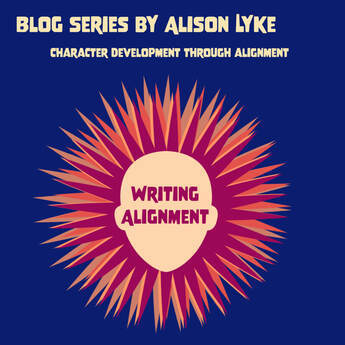 The Situation Deciding a character’s alignment helps determine how’d they’d act during their adventures. I find it helpful to think about how each alignment would behave in the same circumstances because it highlights the differences between each alignment.
The Situation Deciding a character’s alignment helps determine how’d they’d act during their adventures. I find it helpful to think about how each alignment would behave in the same circumstances because it highlights the differences between each alignment.
Here’s the scene:
A character is in a market and encounters a thief who has stolen from them in a previous incident. The thief doesn’t see the character yet, so they have time to react. How will they act?
 In our scenario, a chaotic good character may pull a harmless prank or trick to expose them as a thief and/or force them to give them back the stolen money or goods. She’s as likely to give away her returned goods as she is to keep them. She will also let the thief keep the stolen goods if he has a satisfactory explanation for his thievery or a compelling need for the pinched property.
In our scenario, a chaotic good character may pull a harmless prank or trick to expose them as a thief and/or force them to give them back the stolen money or goods. She’s as likely to give away her returned goods as she is to keep them. She will also let the thief keep the stolen goods if he has a satisfactory explanation for his thievery or a compelling need for the pinched property.
Defining Chaotic Good Characters This alignment encompasses many people’s favorite heroes because chaotic good characters are fun, light, and unpredictable. These types answer to no one, but they have a moral compass. They are unlikely to be affiliated with any organization, religion, or government, at least for any length of time. Chaotic good characters are undisciplined nice guys, rebels who fight against evil establishments, and anti-heroes.
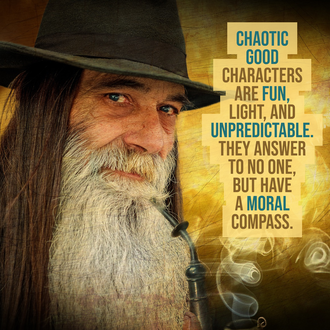 Chaotic good characters are not entirely selfless. They often wrestle with what group to support, which accounts for some of their chaos. For example, should they act in favor of their adventuring group, or the whole country? What if the needs of these two groups are at odds? Chaotic good characters are moral as part of their nature, and not from following a dogma, so they are often helpful to whoever is physically close or can come up with the most convincing request for aid.
Chaotic good characters are not entirely selfless. They often wrestle with what group to support, which accounts for some of their chaos. For example, should they act in favor of their adventuring group, or the whole country? What if the needs of these two groups are at odds? Chaotic good characters are moral as part of their nature, and not from following a dogma, so they are often helpful to whoever is physically close or can come up with the most convincing request for aid.
Chaotic Good Character Development A chaotic good character has a lot of room to develop over a story arc. She may start out as a benevolent trickster and evolve into an incorruptible warrior. Her development often comes from wisdom, since she doesn’t follow the rules, she is guided only by her own intellect.
A foolish or inexperienced chaotic good character will make a lot of mistakes. She will struggle with false allies and have a hard time forecasting the ultimate result of her actions, sometimes leading to calamity.
As she develops, she’ll become better at reading people, and she’ll figure out who deserves her trust. Additionally, seasoned agents of chaos become adept at predicting the outcomes of situations, because they’ve seen it all throughout their tumultuous life. If she develops keen foresight, a chaotic good character may eventually become a wise sage, who takes seemingly random actions that ultimately lead to miraculous results.
Chaotic Good Character Examples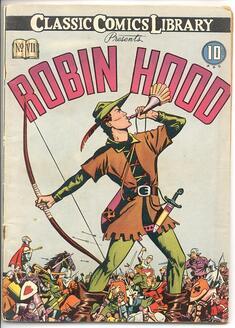 Robin Hood is the classic, chaotic good character. In all his forms throughout literature, he famously flouts the law and ferociously fights a corrupt government. His loose organization, the Merry Men, has no formal structure and a likely filthy living situation out in the woods. They probably all need baths. Poor Maid Marian.
Robin Hood is the classic, chaotic good character. In all his forms throughout literature, he famously flouts the law and ferociously fights a corrupt government. His loose organization, the Merry Men, has no formal structure and a likely filthy living situation out in the woods. They probably all need baths. Poor Maid Marian.
The Wizard Merlin from the myriad of Kind Arthur tales, and specifically from The Once and Future King, is the seasoned sage chaotic good archetype. He shows up at random, his methods are suspect, but his outcomes are (usually) marvelous. He sometimes makes mistakes or gets distracted, but Merlin is altruistic and always gravitates toward righteousness.
Han Solo from the Star Wars franchise is a rebellious chaotic good character. He is, at first, good only to his companions, but his virtue soon extends to all the rebel forces as he joins their fight against malevolence. Early in his journey, he has some of the issues we see with inexperienced chaotic good characters, including treacherous collaborators and imprudence.
That’s it for this week. Next week I’ll be discussing Chaotic Neutral Characters. May the Force be with you!
Other Blogs in This Series:Intro to AlignmentLawful Good
 The Situation Deciding a character’s alignment helps determine how’d they’d act during their adventures. I find it helpful to think about how each alignment would behave in the same circumstances because it highlights the differences between each alignment.
The Situation Deciding a character’s alignment helps determine how’d they’d act during their adventures. I find it helpful to think about how each alignment would behave in the same circumstances because it highlights the differences between each alignment.
Here’s the scene:
A character is in a market and encounters a thief who has stolen from them in a previous incident. The thief doesn’t see the character yet, so they have time to react. How will they act?
 In our scenario, a chaotic good character may pull a harmless prank or trick to expose them as a thief and/or force them to give them back the stolen money or goods. She’s as likely to give away her returned goods as she is to keep them. She will also let the thief keep the stolen goods if he has a satisfactory explanation for his thievery or a compelling need for the pinched property.
In our scenario, a chaotic good character may pull a harmless prank or trick to expose them as a thief and/or force them to give them back the stolen money or goods. She’s as likely to give away her returned goods as she is to keep them. She will also let the thief keep the stolen goods if he has a satisfactory explanation for his thievery or a compelling need for the pinched property. Defining Chaotic Good Characters This alignment encompasses many people’s favorite heroes because chaotic good characters are fun, light, and unpredictable. These types answer to no one, but they have a moral compass. They are unlikely to be affiliated with any organization, religion, or government, at least for any length of time. Chaotic good characters are undisciplined nice guys, rebels who fight against evil establishments, and anti-heroes.
 Chaotic good characters are not entirely selfless. They often wrestle with what group to support, which accounts for some of their chaos. For example, should they act in favor of their adventuring group, or the whole country? What if the needs of these two groups are at odds? Chaotic good characters are moral as part of their nature, and not from following a dogma, so they are often helpful to whoever is physically close or can come up with the most convincing request for aid.
Chaotic good characters are not entirely selfless. They often wrestle with what group to support, which accounts for some of their chaos. For example, should they act in favor of their adventuring group, or the whole country? What if the needs of these two groups are at odds? Chaotic good characters are moral as part of their nature, and not from following a dogma, so they are often helpful to whoever is physically close or can come up with the most convincing request for aid. Chaotic Good Character Development A chaotic good character has a lot of room to develop over a story arc. She may start out as a benevolent trickster and evolve into an incorruptible warrior. Her development often comes from wisdom, since she doesn’t follow the rules, she is guided only by her own intellect.
A foolish or inexperienced chaotic good character will make a lot of mistakes. She will struggle with false allies and have a hard time forecasting the ultimate result of her actions, sometimes leading to calamity.
As she develops, she’ll become better at reading people, and she’ll figure out who deserves her trust. Additionally, seasoned agents of chaos become adept at predicting the outcomes of situations, because they’ve seen it all throughout their tumultuous life. If she develops keen foresight, a chaotic good character may eventually become a wise sage, who takes seemingly random actions that ultimately lead to miraculous results.
Chaotic Good Character Examples
 Robin Hood is the classic, chaotic good character. In all his forms throughout literature, he famously flouts the law and ferociously fights a corrupt government. His loose organization, the Merry Men, has no formal structure and a likely filthy living situation out in the woods. They probably all need baths. Poor Maid Marian.
Robin Hood is the classic, chaotic good character. In all his forms throughout literature, he famously flouts the law and ferociously fights a corrupt government. His loose organization, the Merry Men, has no formal structure and a likely filthy living situation out in the woods. They probably all need baths. Poor Maid Marian.The Wizard Merlin from the myriad of Kind Arthur tales, and specifically from The Once and Future King, is the seasoned sage chaotic good archetype. He shows up at random, his methods are suspect, but his outcomes are (usually) marvelous. He sometimes makes mistakes or gets distracted, but Merlin is altruistic and always gravitates toward righteousness.
Han Solo from the Star Wars franchise is a rebellious chaotic good character. He is, at first, good only to his companions, but his virtue soon extends to all the rebel forces as he joins their fight against malevolence. Early in his journey, he has some of the issues we see with inexperienced chaotic good characters, including treacherous collaborators and imprudence.
That’s it for this week. Next week I’ll be discussing Chaotic Neutral Characters. May the Force be with you!
Other Blogs in This Series:Intro to AlignmentLawful Good
Published on June 06, 2020 08:01
May 29, 2020
Writing Alignment: Lawful Good
This blog series is adapted from a section of an online workshop I conducted for Writers & Books in March 2020. 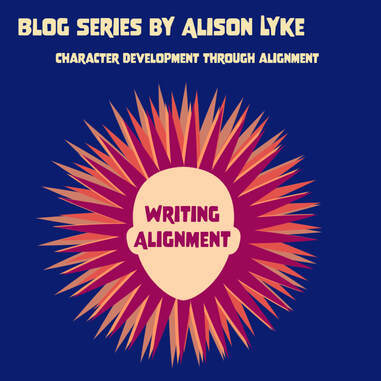 The Situation Deciding a character’s alignment helps determine how’d they’d act during their adventures. I find it helpful to think about how each alignment would behave in the same circumstances because it highlights the differences between each alignment.
The Situation Deciding a character’s alignment helps determine how’d they’d act during their adventures. I find it helpful to think about how each alignment would behave in the same circumstances because it highlights the differences between each alignment.  Here’s the scene:
Here’s the scene:
A character is in a market and encounters a thief who has stolen from them in a previous incident. The thief doesn’t see the character yet, so they have time to react. How will they act?
A lawful good character would call the authorities and explain the situation, sure the police would handle the thief. He has a set of principles in line with the laws of his society, and he expects most people to follow these ideals as well.
The exception would be if he lived in an evil society where the laws are unjust. In that case, the lawful good character would follow the dogma of his religion or established philosophical principles.
Defining Lawful Good Characters
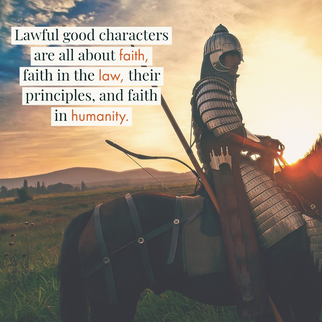 Lawful good characters are all about faith, faith in the law, their principles, and faith in humanity. There are several types and sub-types of lawful good characters, including the “knight in shining armor” and the hand-wringing types.
Lawful good characters are all about faith, faith in the law, their principles, and faith in humanity. There are several types and sub-types of lawful good characters, including the “knight in shining armor” and the hand-wringing types.
The “shining armor” sub-type is a classic hero who believes in upholding all that is just and right, often at the expense of their personal safety. These characters seek out professions that allow them to embody gallantry, i.e., knights, paladins, superheroes, soldiers, and law enforcement.
Not all lawful good characters are about heroics. The hand-wringing type just wants to be good and urges everyone else to follow the rules as well. Hand-wringers get upset when they break unfair rules, but their goodness wins out over perceived lawfulness, eventually.
All types of lawful good characters are aligned with what is best for the greater good of society, within the framework of their chosen belief system. And, they will always have a chosen, defined faith, whether it’s linked to a country, religion, philosophy, or organization. Lawful Good Character Examples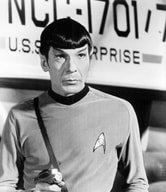 Superman is the “shining armor” type to a tee. He’s a Boy Scout on steroids. Mr. Kent wants to help everyone and uphold the law. He wants you to upload the law too… or else.
Superman is the “shining armor” type to a tee. He’s a Boy Scout on steroids. Mr. Kent wants to help everyone and uphold the law. He wants you to upload the law too… or else.
Hermione Granger from the Harry Potter books is the hand-wringing sub-type of lawful good, at least at the start of the series. She’s learned all the rules and expectations of the wizarding world and expects they’ll be followed.
Mr. Spock from Star Trek is bound to his Vulcan upbringing and the laws of logic. Spock applies his logical framework to all situations regardless of the surrounding rules and social norms. He’s a great example of a lawful good character with a portable philosophy. Next week I’m discussing lawful neutral characters. In the meantime, live long and prosper. Other Blogs in this Series:Intro to Writing Alignment
 The Situation Deciding a character’s alignment helps determine how’d they’d act during their adventures. I find it helpful to think about how each alignment would behave in the same circumstances because it highlights the differences between each alignment.
The Situation Deciding a character’s alignment helps determine how’d they’d act during their adventures. I find it helpful to think about how each alignment would behave in the same circumstances because it highlights the differences between each alignment.  Here’s the scene:
Here’s the scene:A character is in a market and encounters a thief who has stolen from them in a previous incident. The thief doesn’t see the character yet, so they have time to react. How will they act?
A lawful good character would call the authorities and explain the situation, sure the police would handle the thief. He has a set of principles in line with the laws of his society, and he expects most people to follow these ideals as well.
The exception would be if he lived in an evil society where the laws are unjust. In that case, the lawful good character would follow the dogma of his religion or established philosophical principles.
Defining Lawful Good Characters
 Lawful good characters are all about faith, faith in the law, their principles, and faith in humanity. There are several types and sub-types of lawful good characters, including the “knight in shining armor” and the hand-wringing types.
Lawful good characters are all about faith, faith in the law, their principles, and faith in humanity. There are several types and sub-types of lawful good characters, including the “knight in shining armor” and the hand-wringing types.The “shining armor” sub-type is a classic hero who believes in upholding all that is just and right, often at the expense of their personal safety. These characters seek out professions that allow them to embody gallantry, i.e., knights, paladins, superheroes, soldiers, and law enforcement.
Not all lawful good characters are about heroics. The hand-wringing type just wants to be good and urges everyone else to follow the rules as well. Hand-wringers get upset when they break unfair rules, but their goodness wins out over perceived lawfulness, eventually.
All types of lawful good characters are aligned with what is best for the greater good of society, within the framework of their chosen belief system. And, they will always have a chosen, defined faith, whether it’s linked to a country, religion, philosophy, or organization. Lawful Good Character Examples
 Superman is the “shining armor” type to a tee. He’s a Boy Scout on steroids. Mr. Kent wants to help everyone and uphold the law. He wants you to upload the law too… or else.
Superman is the “shining armor” type to a tee. He’s a Boy Scout on steroids. Mr. Kent wants to help everyone and uphold the law. He wants you to upload the law too… or else.Hermione Granger from the Harry Potter books is the hand-wringing sub-type of lawful good, at least at the start of the series. She’s learned all the rules and expectations of the wizarding world and expects they’ll be followed.
Mr. Spock from Star Trek is bound to his Vulcan upbringing and the laws of logic. Spock applies his logical framework to all situations regardless of the surrounding rules and social norms. He’s a great example of a lawful good character with a portable philosophy. Next week I’m discussing lawful neutral characters. In the meantime, live long and prosper. Other Blogs in this Series:Intro to Writing Alignment
Published on May 29, 2020 08:48
May 22, 2020
New Blog Series: Writing Alignment
This blog series is adapted from a section of an online workshop I conducted for Writers & Books in March 2020. 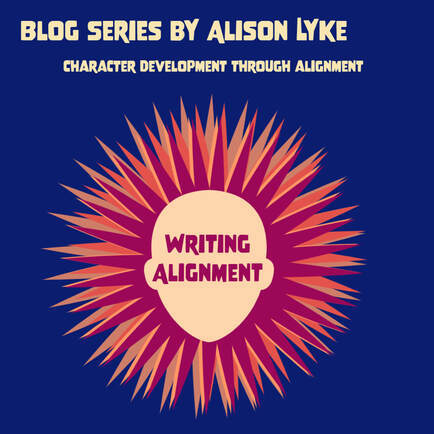 What is Character Alignment? Character alignment is one of the character metrics in the tabletop role-playing game Dungeons and Dragons. Stop rolling your eyes, hear me out.
What is Character Alignment? Character alignment is one of the character metrics in the tabletop role-playing game Dungeons and Dragons. Stop rolling your eyes, hear me out.
First, a quick rundown of D&D. In the game, you create a character, and then the Dungeon Master creates a scenario for a player’s character to run through. Some of the steps in creating a Dungeons and Dragon character can help craft literary sci-fi and fantasy characters. For example, “character alignment” helps determine how a character might act as they navigate the Dungeon Master’s narrative. Assigning this same metric to a literary character can help assess their actions withing a story’s narrative.
Two facets combine to make a character’s alignment: how the character interacts with authority and society, and the character’s morality. As far as societal interaction, the character can either be lawful, chaotic, or neutral. For virtue, characters can be good, evil, or neutral. These two facets combine to make nine alignments: lawful good, lawful neutral, lawful evil, chaotic good, chaotic neutral, chaotic evil, neutral good, neutral evil, and true neutral.
Alignment Memes
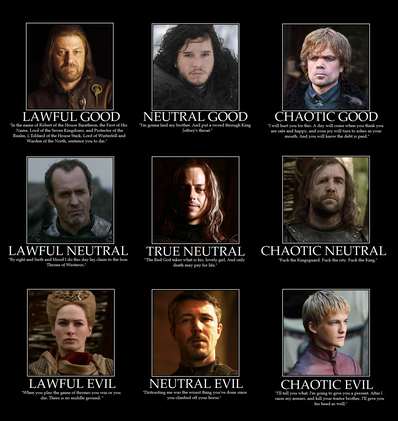 There are a ton of charts online dividing characters from popular movies, T.V. shows, and books up into their character alignments. This one features the characters from Game of Thrones, which gives you an idea of what type of characters fall into which category. Here’s a Doctor Who meme along these same lines:
There are a ton of charts online dividing characters from popular movies, T.V. shows, and books up into their character alignments. This one features the characters from Game of Thrones, which gives you an idea of what type of characters fall into which category. Here’s a Doctor Who meme along these same lines: 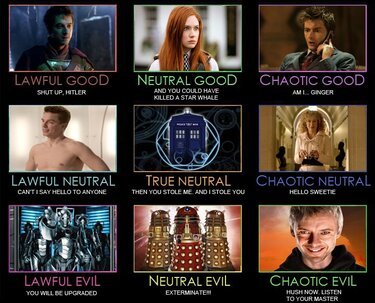 The Situation Throughout this blog series, I plan to explore what these alignments mean to literary character creation and development. I’m going to discuss traits linked to them, but, more importantly, I’m going to explain how each of these character alignments might act in a given situation. That’s the most critical aspect of this type of classification, it helps you figure out how a character will adventure.
The Situation Throughout this blog series, I plan to explore what these alignments mean to literary character creation and development. I’m going to discuss traits linked to them, but, more importantly, I’m going to explain how each of these character alignments might act in a given situation. That’s the most critical aspect of this type of classification, it helps you figure out how a character will adventure.
So, here’s the situation I’m going to discuss, alongside the nine alignments: a character is in a market and encounters a thief who has stolen from them in a previous incident. The thief doesn’t see the character yet, so they have time to react. How will they act? – Each alignment approaches this situation in a very different way.
Next week, I’ll tackle the first alignment, Lawful Good.
 What is Character Alignment? Character alignment is one of the character metrics in the tabletop role-playing game Dungeons and Dragons. Stop rolling your eyes, hear me out.
What is Character Alignment? Character alignment is one of the character metrics in the tabletop role-playing game Dungeons and Dragons. Stop rolling your eyes, hear me out.First, a quick rundown of D&D. In the game, you create a character, and then the Dungeon Master creates a scenario for a player’s character to run through. Some of the steps in creating a Dungeons and Dragon character can help craft literary sci-fi and fantasy characters. For example, “character alignment” helps determine how a character might act as they navigate the Dungeon Master’s narrative. Assigning this same metric to a literary character can help assess their actions withing a story’s narrative.
Two facets combine to make a character’s alignment: how the character interacts with authority and society, and the character’s morality. As far as societal interaction, the character can either be lawful, chaotic, or neutral. For virtue, characters can be good, evil, or neutral. These two facets combine to make nine alignments: lawful good, lawful neutral, lawful evil, chaotic good, chaotic neutral, chaotic evil, neutral good, neutral evil, and true neutral.
Alignment Memes
 There are a ton of charts online dividing characters from popular movies, T.V. shows, and books up into their character alignments. This one features the characters from Game of Thrones, which gives you an idea of what type of characters fall into which category. Here’s a Doctor Who meme along these same lines:
There are a ton of charts online dividing characters from popular movies, T.V. shows, and books up into their character alignments. This one features the characters from Game of Thrones, which gives you an idea of what type of characters fall into which category. Here’s a Doctor Who meme along these same lines:  The Situation Throughout this blog series, I plan to explore what these alignments mean to literary character creation and development. I’m going to discuss traits linked to them, but, more importantly, I’m going to explain how each of these character alignments might act in a given situation. That’s the most critical aspect of this type of classification, it helps you figure out how a character will adventure.
The Situation Throughout this blog series, I plan to explore what these alignments mean to literary character creation and development. I’m going to discuss traits linked to them, but, more importantly, I’m going to explain how each of these character alignments might act in a given situation. That’s the most critical aspect of this type of classification, it helps you figure out how a character will adventure.
So, here’s the situation I’m going to discuss, alongside the nine alignments: a character is in a market and encounters a thief who has stolen from them in a previous incident. The thief doesn’t see the character yet, so they have time to react. How will they act? – Each alignment approaches this situation in a very different way.
Next week, I’ll tackle the first alignment, Lawful Good.
Published on May 22, 2020 13:51
May 15, 2020
Introducing: Tripping the Multiverse
This week I announced my newest book on my social media platforms. Tripping the Multiverse will be launched on January 21st, 2021, published by Black Rose Writing, the same house that published Forever People.
While 1/21/21 is a cool, palindromic date, it seems quite far away. But, it’s only nine months, and I have a lot of events planned for the book, including a cover reveal, a Goodreads Giveaway, and a book tour. Make sure to sign up for my monthly newsletter so you can keep up with all the developments.
I’m excited about Tripping the Multiverse for a ton of reasons. It’s the first in my Jade & Antigone series, which follows the adventures of a pair of science journalists who turned into reluctant heroes. It’s a lighthearted exploration of other worlds and alternate realities. Synopsis After attending a disastrous wormhole experiment at the mysterious Orion Center, rival science journalists, shy and brilliant Jade, and saucy Antigone gain unstable superpowers. This unlikely pair must learn to work together as they jump from dimension to dimension in search of a rogue scientist in a race against the clock to fix their broken home-world Characters Jade lives with her parents and sister, who is a locally well-known actress. Jade overcame her extreme shyness to secure her dream job as a science journalist. Jade’s freelance journalist gig doesn’t pay enough for her to leave home or the shadow of her younger sister. The failed experiment at the Orion Center gave Jade something she’s always secretly wanted– the ability to disappear into someone, or something, else.
Synopsis After attending a disastrous wormhole experiment at the mysterious Orion Center, rival science journalists, shy and brilliant Jade, and saucy Antigone gain unstable superpowers. This unlikely pair must learn to work together as they jump from dimension to dimension in search of a rogue scientist in a race against the clock to fix their broken home-world Characters Jade lives with her parents and sister, who is a locally well-known actress. Jade overcame her extreme shyness to secure her dream job as a science journalist. Jade’s freelance journalist gig doesn’t pay enough for her to leave home or the shadow of her younger sister. The failed experiment at the Orion Center gave Jade something she’s always secretly wanted– the ability to disappear into someone, or something, else.
Antigone, who would be known to her friends as Anti, if she had any, landed her job at the science journal through a series of tragic missteps. She flunked out of med school, and her father had to pull a few strings to secure her a job. Anti would rather be eating take-out while reading Bukowski or watching her favorite T.V. show, Boat Murdered. Unfortunately, the accident at the Orion Center shifted her into an alternate dimension where Boat Murdered never existed, so Anti must use her newly acquired extra-dimensional sentience to find her way home.
Other charters include Dr. Gustavo Osborne, an enterprising internet celebrity who investigates otherworldly phenomena along with his peppy Maltese dog, Eliot. And Harriet, the Orion Center’s eccentric and demanding research director. I’m planning on writing a new blog series of nine blogs on character creation starting next week, but after that, I’ll write another Tripping the Multiverse teaser. The next one will feature some of the surreal worlds of Tripping the Multiverse.
While 1/21/21 is a cool, palindromic date, it seems quite far away. But, it’s only nine months, and I have a lot of events planned for the book, including a cover reveal, a Goodreads Giveaway, and a book tour. Make sure to sign up for my monthly newsletter so you can keep up with all the developments.
I’m excited about Tripping the Multiverse for a ton of reasons. It’s the first in my Jade & Antigone series, which follows the adventures of a pair of science journalists who turned into reluctant heroes. It’s a lighthearted exploration of other worlds and alternate realities.
 Synopsis After attending a disastrous wormhole experiment at the mysterious Orion Center, rival science journalists, shy and brilliant Jade, and saucy Antigone gain unstable superpowers. This unlikely pair must learn to work together as they jump from dimension to dimension in search of a rogue scientist in a race against the clock to fix their broken home-world Characters Jade lives with her parents and sister, who is a locally well-known actress. Jade overcame her extreme shyness to secure her dream job as a science journalist. Jade’s freelance journalist gig doesn’t pay enough for her to leave home or the shadow of her younger sister. The failed experiment at the Orion Center gave Jade something she’s always secretly wanted– the ability to disappear into someone, or something, else.
Synopsis After attending a disastrous wormhole experiment at the mysterious Orion Center, rival science journalists, shy and brilliant Jade, and saucy Antigone gain unstable superpowers. This unlikely pair must learn to work together as they jump from dimension to dimension in search of a rogue scientist in a race against the clock to fix their broken home-world Characters Jade lives with her parents and sister, who is a locally well-known actress. Jade overcame her extreme shyness to secure her dream job as a science journalist. Jade’s freelance journalist gig doesn’t pay enough for her to leave home or the shadow of her younger sister. The failed experiment at the Orion Center gave Jade something she’s always secretly wanted– the ability to disappear into someone, or something, else.Antigone, who would be known to her friends as Anti, if she had any, landed her job at the science journal through a series of tragic missteps. She flunked out of med school, and her father had to pull a few strings to secure her a job. Anti would rather be eating take-out while reading Bukowski or watching her favorite T.V. show, Boat Murdered. Unfortunately, the accident at the Orion Center shifted her into an alternate dimension where Boat Murdered never existed, so Anti must use her newly acquired extra-dimensional sentience to find her way home.
Other charters include Dr. Gustavo Osborne, an enterprising internet celebrity who investigates otherworldly phenomena along with his peppy Maltese dog, Eliot. And Harriet, the Orion Center’s eccentric and demanding research director. I’m planning on writing a new blog series of nine blogs on character creation starting next week, but after that, I’ll write another Tripping the Multiverse teaser. The next one will feature some of the surreal worlds of Tripping the Multiverse.
Published on May 15, 2020 09:06
May 1, 2020
Literature’s Best Villains and Antagonists
This post is written in anticipation of my upcoming takeover of Facebook’s Fantasy and Science-Fiction Readers lounge today (5/1) from 2-4pm est.  World-burning, mayhem- causing villains can be fun, but the best antagonists are the ones who are multifaceted. My favorite antagonists are the ones who have understandable motives and sympathetic plights. There are also villains you love to hate, perhaps because they get away with it, or maybe because they’re only villains to one group of people and heroes to everyone else. Great antagonists and villains live in gray areas where the readers decide right and wrong for themselves.
World-burning, mayhem- causing villains can be fun, but the best antagonists are the ones who are multifaceted. My favorite antagonists are the ones who have understandable motives and sympathetic plights. There are also villains you love to hate, perhaps because they get away with it, or maybe because they’re only villains to one group of people and heroes to everyone else. Great antagonists and villains live in gray areas where the readers decide right and wrong for themselves.
Here are some of my favorite villains and antagonists from literature and why I love them: Javert from Les Misérables by Victor Hugo 
Javert holds the reasonable belief that the law must be followed. Javert came by his hatred for rule-breaking honestly, having been born in prison to criminal parents. His rigid legalism puts him at odds with the protagonist Jean Valjean, who breaks the law out of desperation. When Javert discovers that Valjean is both a criminal and a virtuous person, he is unable to reconcile his cognitive dissonance. Javert is the epitome of a sympathetic villain. There’s not much to like about him, and pursuit of Valjean is frustrating, but it’s easy to understand his point of view. The Comedian from Watchmen by Alan Moore On the other end of the spectrum from the overly responsible Javert is the vile, abusive Comedian (Edward Blake). The Comedian’s murder is the graphic novel’s inciting incident, and the more I read about him, the more I was tempted to say “good riddance.” But, he’s a “Captain America” flavored hero to most of the world. His public heroics are undeniable, and his horrors are hidden to everyone but those who know him best. In a story full of villains, this caustic lowlife stands out.
Long John Silver from Treasure Island by Robert Louis Stevenson  Is there any villain more heinous than the betrayer? Long John Silver looks like a miscreant, with his missing leg and a squawking parrot perched on his shoulder. But, his seemingly kind nature and lowly position as the ship’s cook puts Jim the cabin boy at ease, until Silver orchestrates a mutiny and turns on Jim in a shocking display of treachery. The most villainous aspect of Silver is his capacity to be a good person, as he demonstrates with Jim before the mutiny. He doesn’t have to be malicious. Silver could be a light-hearted “gentleman of fortune;” instead, he’s a black-hearted pirate. Bartleby from “Bartleby the Scrivener” by Herman Melville Bartleby’s catchphrase “I prefer not to” may be the most infuriating line in all of literature. The short story’s unnamed protagonist hires Bartleby as a scrivener for his law office, on the glowing recommendation from a colleague. The suggestion was a trick to get Bartleby off his hands as the scrivener “prefers not to” do any work, with no explanation for his disinclination. Bartleby is a blank slate sort of antagonist because I can see myself in his shoes. Who hasn’t “preferred not to” at some point during their career? Maybe Bartleby is burnt out, or tired of being exploited. Or, perhaps he’s never done any work and found a villainous way to shirk his way through life.
Is there any villain more heinous than the betrayer? Long John Silver looks like a miscreant, with his missing leg and a squawking parrot perched on his shoulder. But, his seemingly kind nature and lowly position as the ship’s cook puts Jim the cabin boy at ease, until Silver orchestrates a mutiny and turns on Jim in a shocking display of treachery. The most villainous aspect of Silver is his capacity to be a good person, as he demonstrates with Jim before the mutiny. He doesn’t have to be malicious. Silver could be a light-hearted “gentleman of fortune;” instead, he’s a black-hearted pirate. Bartleby from “Bartleby the Scrivener” by Herman Melville Bartleby’s catchphrase “I prefer not to” may be the most infuriating line in all of literature. The short story’s unnamed protagonist hires Bartleby as a scrivener for his law office, on the glowing recommendation from a colleague. The suggestion was a trick to get Bartleby off his hands as the scrivener “prefers not to” do any work, with no explanation for his disinclination. Bartleby is a blank slate sort of antagonist because I can see myself in his shoes. Who hasn’t “preferred not to” at some point during their career? Maybe Bartleby is burnt out, or tired of being exploited. Or, perhaps he’s never done any work and found a villainous way to shirk his way through life.
Great antagonists can be so much more than mustache twirlers with a plan for world domination. They can be just as exciting and compelling as the protagonists. You may even find yourself rooting for them, you scoundrel. Who are some of your favorite antagonists?
 World-burning, mayhem- causing villains can be fun, but the best antagonists are the ones who are multifaceted. My favorite antagonists are the ones who have understandable motives and sympathetic plights. There are also villains you love to hate, perhaps because they get away with it, or maybe because they’re only villains to one group of people and heroes to everyone else. Great antagonists and villains live in gray areas where the readers decide right and wrong for themselves.
World-burning, mayhem- causing villains can be fun, but the best antagonists are the ones who are multifaceted. My favorite antagonists are the ones who have understandable motives and sympathetic plights. There are also villains you love to hate, perhaps because they get away with it, or maybe because they’re only villains to one group of people and heroes to everyone else. Great antagonists and villains live in gray areas where the readers decide right and wrong for themselves.
Here are some of my favorite villains and antagonists from literature and why I love them: Javert from Les Misérables by Victor Hugo

Javert holds the reasonable belief that the law must be followed. Javert came by his hatred for rule-breaking honestly, having been born in prison to criminal parents. His rigid legalism puts him at odds with the protagonist Jean Valjean, who breaks the law out of desperation. When Javert discovers that Valjean is both a criminal and a virtuous person, he is unable to reconcile his cognitive dissonance. Javert is the epitome of a sympathetic villain. There’s not much to like about him, and pursuit of Valjean is frustrating, but it’s easy to understand his point of view. The Comedian from Watchmen by Alan Moore On the other end of the spectrum from the overly responsible Javert is the vile, abusive Comedian (Edward Blake). The Comedian’s murder is the graphic novel’s inciting incident, and the more I read about him, the more I was tempted to say “good riddance.” But, he’s a “Captain America” flavored hero to most of the world. His public heroics are undeniable, and his horrors are hidden to everyone but those who know him best. In a story full of villains, this caustic lowlife stands out.
Long John Silver from Treasure Island by Robert Louis Stevenson
 Is there any villain more heinous than the betrayer? Long John Silver looks like a miscreant, with his missing leg and a squawking parrot perched on his shoulder. But, his seemingly kind nature and lowly position as the ship’s cook puts Jim the cabin boy at ease, until Silver orchestrates a mutiny and turns on Jim in a shocking display of treachery. The most villainous aspect of Silver is his capacity to be a good person, as he demonstrates with Jim before the mutiny. He doesn’t have to be malicious. Silver could be a light-hearted “gentleman of fortune;” instead, he’s a black-hearted pirate. Bartleby from “Bartleby the Scrivener” by Herman Melville Bartleby’s catchphrase “I prefer not to” may be the most infuriating line in all of literature. The short story’s unnamed protagonist hires Bartleby as a scrivener for his law office, on the glowing recommendation from a colleague. The suggestion was a trick to get Bartleby off his hands as the scrivener “prefers not to” do any work, with no explanation for his disinclination. Bartleby is a blank slate sort of antagonist because I can see myself in his shoes. Who hasn’t “preferred not to” at some point during their career? Maybe Bartleby is burnt out, or tired of being exploited. Or, perhaps he’s never done any work and found a villainous way to shirk his way through life.
Is there any villain more heinous than the betrayer? Long John Silver looks like a miscreant, with his missing leg and a squawking parrot perched on his shoulder. But, his seemingly kind nature and lowly position as the ship’s cook puts Jim the cabin boy at ease, until Silver orchestrates a mutiny and turns on Jim in a shocking display of treachery. The most villainous aspect of Silver is his capacity to be a good person, as he demonstrates with Jim before the mutiny. He doesn’t have to be malicious. Silver could be a light-hearted “gentleman of fortune;” instead, he’s a black-hearted pirate. Bartleby from “Bartleby the Scrivener” by Herman Melville Bartleby’s catchphrase “I prefer not to” may be the most infuriating line in all of literature. The short story’s unnamed protagonist hires Bartleby as a scrivener for his law office, on the glowing recommendation from a colleague. The suggestion was a trick to get Bartleby off his hands as the scrivener “prefers not to” do any work, with no explanation for his disinclination. Bartleby is a blank slate sort of antagonist because I can see myself in his shoes. Who hasn’t “preferred not to” at some point during their career? Maybe Bartleby is burnt out, or tired of being exploited. Or, perhaps he’s never done any work and found a villainous way to shirk his way through life.Great antagonists can be so much more than mustache twirlers with a plan for world domination. They can be just as exciting and compelling as the protagonists. You may even find yourself rooting for them, you scoundrel. Who are some of your favorite antagonists?
Published on May 01, 2020 07:50
April 11, 2020
Writing the Future #6: Foresight
This is the 6th (and last) post in blog series on writing speculative science fiction. It’s from a workshop I conducted at Writers & Books in February 2020.  The convergence of the social and the tech is what makes a story. Authors project a world into the future, and now create the people who live that future. The character’s movement through this new world is shaped by the tomorrow the author created. Maybe the character will need to overcome the obstacles presented by science or society, perhaps she’ll work with to improve the world, maybe he’ll be the inventor or the catalyst.
The convergence of the social and the tech is what makes a story. Authors project a world into the future, and now create the people who live that future. The character’s movement through this new world is shaped by the tomorrow the author created. Maybe the character will need to overcome the obstacles presented by science or society, perhaps she’ll work with to improve the world, maybe he’ll be the inventor or the catalyst.
Instead of explaining this world, it’s best to give clues about it through the character’s interaction with their environment. Take, for example, Offred’s interaction with her room, upon waking, in A Handmaid’s Tale:
“When the window is partly open--it only opens partly--the air can come in and make the curtains move. I can sit in the chair, or on the window seat, hands folded, and watch this. Sunlight comes in through the window too and falls on the floor, which is made of wood, in narrow strips, highly polished. I can smell the polish. There's a rug on the floor, oval, of braided rags. This is the kind of touch they like: folk art, archaic, made by women, in their spare time, from things that have no further use. A return to traditional values. Waste not want not. I am not being wasted. Why do I want?
On the wall above the chair, a picture, framed but with no glass: a print of flowers, blue irises, watercolor. Flowers are still allowed. Does each of us have the same print, the same chair, the same white curtains, I wonder? Government issue?
Think of it as being in the army, said Aunt Lydia.”
We can tell, just from this description of this future room, that Offred is trapped because the window doesn’t open. Her picture, ominously, doesn’t have glass. We can take a few guesses as to why. It also makes the reader wonder – who is the “us” who gets government furniture and is there a “them” who doesn’t?
The Power of Foresight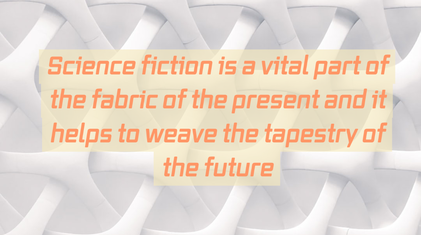 Social and scientific speculation combine in essential ways, and the rest of the world is taking notice. You may find yourself speculating on how climate change will change the future of sports and other outdoor activities. If you do, you could end up among the science fiction writers France has hired to take part in its Defense Innovation Agency – a group of writers who create speculative climate change scenarios for the French military.
Social and scientific speculation combine in essential ways, and the rest of the world is taking notice. You may find yourself speculating on how climate change will change the future of sports and other outdoor activities. If you do, you could end up among the science fiction writers France has hired to take part in its Defense Innovation Agency – a group of writers who create speculative climate change scenarios for the French military.
Whether it’s predicting the future for the military, telling futuristic stories, or philosophizing on the impact of new tech, science fiction is a vital part of the fabric of the present and it helps to weave the tapestry of the future.
Other Blogs in this Series:Blog 1: Writing the FutureBlog #2: Squint at TomorrowBlog #3: The Future is Never HereBlog #4: Sci-Fi as PhilosophyBlog #5: Back to the Future
 The convergence of the social and the tech is what makes a story. Authors project a world into the future, and now create the people who live that future. The character’s movement through this new world is shaped by the tomorrow the author created. Maybe the character will need to overcome the obstacles presented by science or society, perhaps she’ll work with to improve the world, maybe he’ll be the inventor or the catalyst.
The convergence of the social and the tech is what makes a story. Authors project a world into the future, and now create the people who live that future. The character’s movement through this new world is shaped by the tomorrow the author created. Maybe the character will need to overcome the obstacles presented by science or society, perhaps she’ll work with to improve the world, maybe he’ll be the inventor or the catalyst.Instead of explaining this world, it’s best to give clues about it through the character’s interaction with their environment. Take, for example, Offred’s interaction with her room, upon waking, in A Handmaid’s Tale:
“When the window is partly open--it only opens partly--the air can come in and make the curtains move. I can sit in the chair, or on the window seat, hands folded, and watch this. Sunlight comes in through the window too and falls on the floor, which is made of wood, in narrow strips, highly polished. I can smell the polish. There's a rug on the floor, oval, of braided rags. This is the kind of touch they like: folk art, archaic, made by women, in their spare time, from things that have no further use. A return to traditional values. Waste not want not. I am not being wasted. Why do I want?
On the wall above the chair, a picture, framed but with no glass: a print of flowers, blue irises, watercolor. Flowers are still allowed. Does each of us have the same print, the same chair, the same white curtains, I wonder? Government issue?
Think of it as being in the army, said Aunt Lydia.”
We can tell, just from this description of this future room, that Offred is trapped because the window doesn’t open. Her picture, ominously, doesn’t have glass. We can take a few guesses as to why. It also makes the reader wonder – who is the “us” who gets government furniture and is there a “them” who doesn’t?
The Power of Foresight
 Social and scientific speculation combine in essential ways, and the rest of the world is taking notice. You may find yourself speculating on how climate change will change the future of sports and other outdoor activities. If you do, you could end up among the science fiction writers France has hired to take part in its Defense Innovation Agency – a group of writers who create speculative climate change scenarios for the French military.
Social and scientific speculation combine in essential ways, and the rest of the world is taking notice. You may find yourself speculating on how climate change will change the future of sports and other outdoor activities. If you do, you could end up among the science fiction writers France has hired to take part in its Defense Innovation Agency – a group of writers who create speculative climate change scenarios for the French military.Whether it’s predicting the future for the military, telling futuristic stories, or philosophizing on the impact of new tech, science fiction is a vital part of the fabric of the present and it helps to weave the tapestry of the future.
Other Blogs in this Series:Blog 1: Writing the FutureBlog #2: Squint at TomorrowBlog #3: The Future is Never HereBlog #4: Sci-Fi as PhilosophyBlog #5: Back to the Future
Published on April 11, 2020 10:05
April 5, 2020
Writing the Future #5: Back to the Future
This is the #5 post in blog series on writing speculative science fiction. It’s from a workshop I conducted at Writers & Books in February 2020. 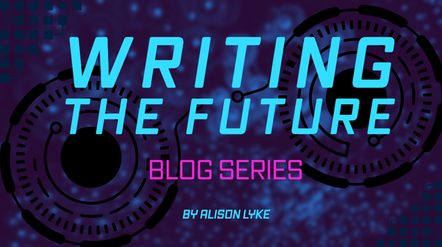 So, now that I’ve covered scientific speculation, on to the softer kind of predictive writing, based on social trends. Social speculation is less of a projection of where we think science could take us and more of a commentary on our current culture. For example, some people think that the internet makes us narcissistic – so what would a future look like where everyone is a raging narcissist; maybe we’re already there.
So, now that I’ve covered scientific speculation, on to the softer kind of predictive writing, based on social trends. Social speculation is less of a projection of where we think science could take us and more of a commentary on our current culture. For example, some people think that the internet makes us narcissistic – so what would a future look like where everyone is a raging narcissist; maybe we’re already there.
The science aspect in world-building and social or trend speculations help to flesh out the characters. The tech may be the “why” of their lives, but the social consequences are the “how.” How your future society functions isn’t necessarily based around an emerging tech either. Just like with tech, you can take any social trend that’s happening now and project it into the future.
Social speculation is often a way for the author to discuss the status quo without direct commentary. Worried about the looming Vietnam War in the wake of the Second World War, Kurt Vonnegut used a man’s encounter with the humorous alien Tralfamadorians in his novel Slaughterhouse-Five. With the alien’s ability to alter time and he wrote harrowing account of the horrors of modern warfare amid comic interactions with the creatures.
Whether you’re imagining the cultural implications of a specific tech – like Gibson’s cyberspace addicted society, or commenting on the direction of trends, akin to Atwood’s commentary on the religious subjugation of women, your characters are uniquely shaped by the futuristic world they inhabit. Just like we’re shaped by the world.
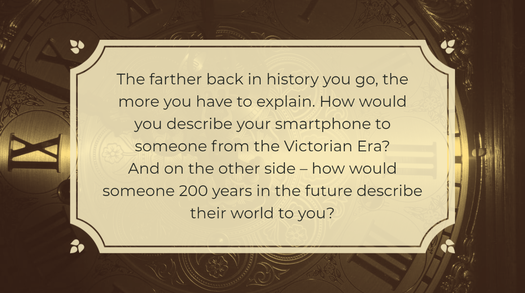 Thought Activity: Back to the Future
Part One: The Past
Thought Activity: Back to the Future
Part One: The Past
There’s a two-part activity I call “Back to the Future,” It plays with time and helps me think about how much society and changes in a few decades. We are somewhat of experts in the community we live in – so imagine describing your current 2020 day, and all the nebulous social constructs and interwoven technologies to someone living in the 1980s. I might say something like – “my phone also has a television and a camera, and I carry it in my hand.”
Part Two: The Future
Now reverse it. How might somebody 40 years in the future describe their day and their technology? Maybe they’d say – “it’s like your smartphone, but implanted in your visual cortex. It blurs other people’s faces in public to protect privacy.” So, it’s 2060 – walk us through a day, or a character’s day. What tech or trend has advanced, what’s obsolete, what’s brand new?
The farther back in history you get, the more you have to explain. How would you describe your smartphone to someone from the Victorian Era? Maybe you’d just say it’s “voices and pictures from someone very far away.” And on the other side – how would someone 200 years in the future describe their world to you? – Probably with similar vagueness and logical leaps. When speculating, it’s important to remember that you’re an expert on the present and near future, but the farther you get away from current society, the more unfamiliar your constructed world will become. Other Blogs in this Series:Blog 1: Writing the FutureBlog #2: Squint at TomorrowBlog #3: The Future is Never HereBlog #4: Sci-Fi as Philosophy
 So, now that I’ve covered scientific speculation, on to the softer kind of predictive writing, based on social trends. Social speculation is less of a projection of where we think science could take us and more of a commentary on our current culture. For example, some people think that the internet makes us narcissistic – so what would a future look like where everyone is a raging narcissist; maybe we’re already there.
So, now that I’ve covered scientific speculation, on to the softer kind of predictive writing, based on social trends. Social speculation is less of a projection of where we think science could take us and more of a commentary on our current culture. For example, some people think that the internet makes us narcissistic – so what would a future look like where everyone is a raging narcissist; maybe we’re already there.The science aspect in world-building and social or trend speculations help to flesh out the characters. The tech may be the “why” of their lives, but the social consequences are the “how.” How your future society functions isn’t necessarily based around an emerging tech either. Just like with tech, you can take any social trend that’s happening now and project it into the future.
Social speculation is often a way for the author to discuss the status quo without direct commentary. Worried about the looming Vietnam War in the wake of the Second World War, Kurt Vonnegut used a man’s encounter with the humorous alien Tralfamadorians in his novel Slaughterhouse-Five. With the alien’s ability to alter time and he wrote harrowing account of the horrors of modern warfare amid comic interactions with the creatures.
Whether you’re imagining the cultural implications of a specific tech – like Gibson’s cyberspace addicted society, or commenting on the direction of trends, akin to Atwood’s commentary on the religious subjugation of women, your characters are uniquely shaped by the futuristic world they inhabit. Just like we’re shaped by the world.
 Thought Activity: Back to the Future
Part One: The Past
Thought Activity: Back to the Future
Part One: The Past
There’s a two-part activity I call “Back to the Future,” It plays with time and helps me think about how much society and changes in a few decades. We are somewhat of experts in the community we live in – so imagine describing your current 2020 day, and all the nebulous social constructs and interwoven technologies to someone living in the 1980s. I might say something like – “my phone also has a television and a camera, and I carry it in my hand.”
Part Two: The Future
Now reverse it. How might somebody 40 years in the future describe their day and their technology? Maybe they’d say – “it’s like your smartphone, but implanted in your visual cortex. It blurs other people’s faces in public to protect privacy.” So, it’s 2060 – walk us through a day, or a character’s day. What tech or trend has advanced, what’s obsolete, what’s brand new?
The farther back in history you get, the more you have to explain. How would you describe your smartphone to someone from the Victorian Era? Maybe you’d just say it’s “voices and pictures from someone very far away.” And on the other side – how would someone 200 years in the future describe their world to you? – Probably with similar vagueness and logical leaps. When speculating, it’s important to remember that you’re an expert on the present and near future, but the farther you get away from current society, the more unfamiliar your constructed world will become. Other Blogs in this Series:Blog 1: Writing the FutureBlog #2: Squint at TomorrowBlog #3: The Future is Never HereBlog #4: Sci-Fi as Philosophy
Published on April 05, 2020 06:10
March 28, 2020
Writing the Future #4: Sci-Fi as Philosophy
This is the #3 post in blog series on writing speculative science fiction. It’s from a workshop I conducted at Writers & Books in February 2020. 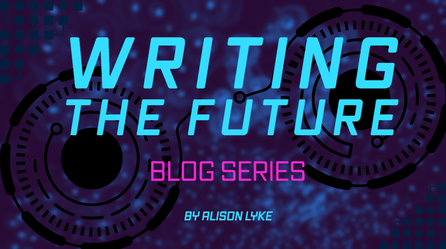 In an earlier blog in this series, I said technology is inert if you don’t use it. But unused tech isn’t a reality, and there’s often a direction to take- a choice that goes hand in hand with the invention. Nuclear fusion can be used for cheap power or to destroy whole countries. Social media can uplift and connect, or it can spread misinformation and lower self-worth.
In an earlier blog in this series, I said technology is inert if you don’t use it. But unused tech isn’t a reality, and there’s often a direction to take- a choice that goes hand in hand with the invention. Nuclear fusion can be used for cheap power or to destroy whole countries. Social media can uplift and connect, or it can spread misinformation and lower self-worth.
Speculating on the direction of tech use helps shape the actual course of the tech once it’s adopted. Ancient religious texts, philosophical dogma, even the proclamations of rambling 60’s beat poets have little bearing on our current world, which is dominated by hyper-fast wi-fi and 24-hour connection.
Here, sci-fi writers become philosophers. We look to them to present a possible future and to help decide if that’s what we’d like our world to look like. Science-fiction leans toward the dystopian because often, writers wander into the future and run back with dire warnings. However, sci-fi can also offer us a peek into the utopias that may be possible if we play our cards right. The best work provides outcomes that are both positive and negative. This is the most realistic because it’s true to how things work out – nuclear fusion is both, social media is both.
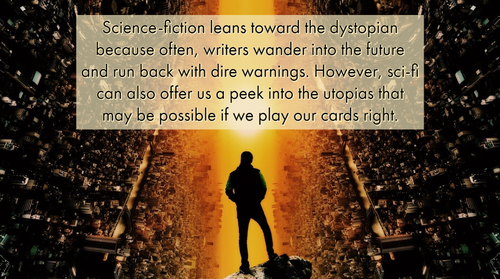 Asimov sought to present a future where we lived side-by-side with A.I. in mutually supportive relationships. He aimed to foster respect for this new kind of intelligence as a counter to the popular stories of evil robots rising up and overtaking humanity. Asimov’s ideas have been around for decades and it’s possible, if not probable that his philosophies regarding the respect and care of A.I. are reflected in the development of the technology.
Asimov sought to present a future where we lived side-by-side with A.I. in mutually supportive relationships. He aimed to foster respect for this new kind of intelligence as a counter to the popular stories of evil robots rising up and overtaking humanity. Asimov’s ideas have been around for decades and it’s possible, if not probable that his philosophies regarding the respect and care of A.I. are reflected in the development of the technology.
Of course, the advancement of helpful androids is to everyone’s benefit, especially the people who stand to benefit financially from their creation. Scientific speculation is often tied tightly to the soul of American consumerism. With only a little nudge, you can dream up things that people want. Watchers of the original Star Trek dreamt of the day when they could see the person on the other end of the telephone, just like an angry admiral popping up on the screen to admonish Kirk for his latest tawdry escapade. Or, years later, viewers saw and coveted the all-in-one portable tablet computers on the show’s successor, The Next Generation.
The capitalist version of sci-fi speculation may be the path of least resistance. You dream up a product you’d like and imagine what the world would be like if everyone had access to it – be it flying cars, self-cleaning clothes, or an immorality serum. Other Blogs in this Series:Blog 1: Writing the FutureBlog #2: Squint at TomorrowBlog #3: The Future is Never Here
 In an earlier blog in this series, I said technology is inert if you don’t use it. But unused tech isn’t a reality, and there’s often a direction to take- a choice that goes hand in hand with the invention. Nuclear fusion can be used for cheap power or to destroy whole countries. Social media can uplift and connect, or it can spread misinformation and lower self-worth.
In an earlier blog in this series, I said technology is inert if you don’t use it. But unused tech isn’t a reality, and there’s often a direction to take- a choice that goes hand in hand with the invention. Nuclear fusion can be used for cheap power or to destroy whole countries. Social media can uplift and connect, or it can spread misinformation and lower self-worth.
Speculating on the direction of tech use helps shape the actual course of the tech once it’s adopted. Ancient religious texts, philosophical dogma, even the proclamations of rambling 60’s beat poets have little bearing on our current world, which is dominated by hyper-fast wi-fi and 24-hour connection.
Here, sci-fi writers become philosophers. We look to them to present a possible future and to help decide if that’s what we’d like our world to look like. Science-fiction leans toward the dystopian because often, writers wander into the future and run back with dire warnings. However, sci-fi can also offer us a peek into the utopias that may be possible if we play our cards right. The best work provides outcomes that are both positive and negative. This is the most realistic because it’s true to how things work out – nuclear fusion is both, social media is both.
 Asimov sought to present a future where we lived side-by-side with A.I. in mutually supportive relationships. He aimed to foster respect for this new kind of intelligence as a counter to the popular stories of evil robots rising up and overtaking humanity. Asimov’s ideas have been around for decades and it’s possible, if not probable that his philosophies regarding the respect and care of A.I. are reflected in the development of the technology.
Asimov sought to present a future where we lived side-by-side with A.I. in mutually supportive relationships. He aimed to foster respect for this new kind of intelligence as a counter to the popular stories of evil robots rising up and overtaking humanity. Asimov’s ideas have been around for decades and it’s possible, if not probable that his philosophies regarding the respect and care of A.I. are reflected in the development of the technology.Of course, the advancement of helpful androids is to everyone’s benefit, especially the people who stand to benefit financially from their creation. Scientific speculation is often tied tightly to the soul of American consumerism. With only a little nudge, you can dream up things that people want. Watchers of the original Star Trek dreamt of the day when they could see the person on the other end of the telephone, just like an angry admiral popping up on the screen to admonish Kirk for his latest tawdry escapade. Or, years later, viewers saw and coveted the all-in-one portable tablet computers on the show’s successor, The Next Generation.
The capitalist version of sci-fi speculation may be the path of least resistance. You dream up a product you’d like and imagine what the world would be like if everyone had access to it – be it flying cars, self-cleaning clothes, or an immorality serum. Other Blogs in this Series:Blog 1: Writing the FutureBlog #2: Squint at TomorrowBlog #3: The Future is Never Here
Published on March 28, 2020 07:06



